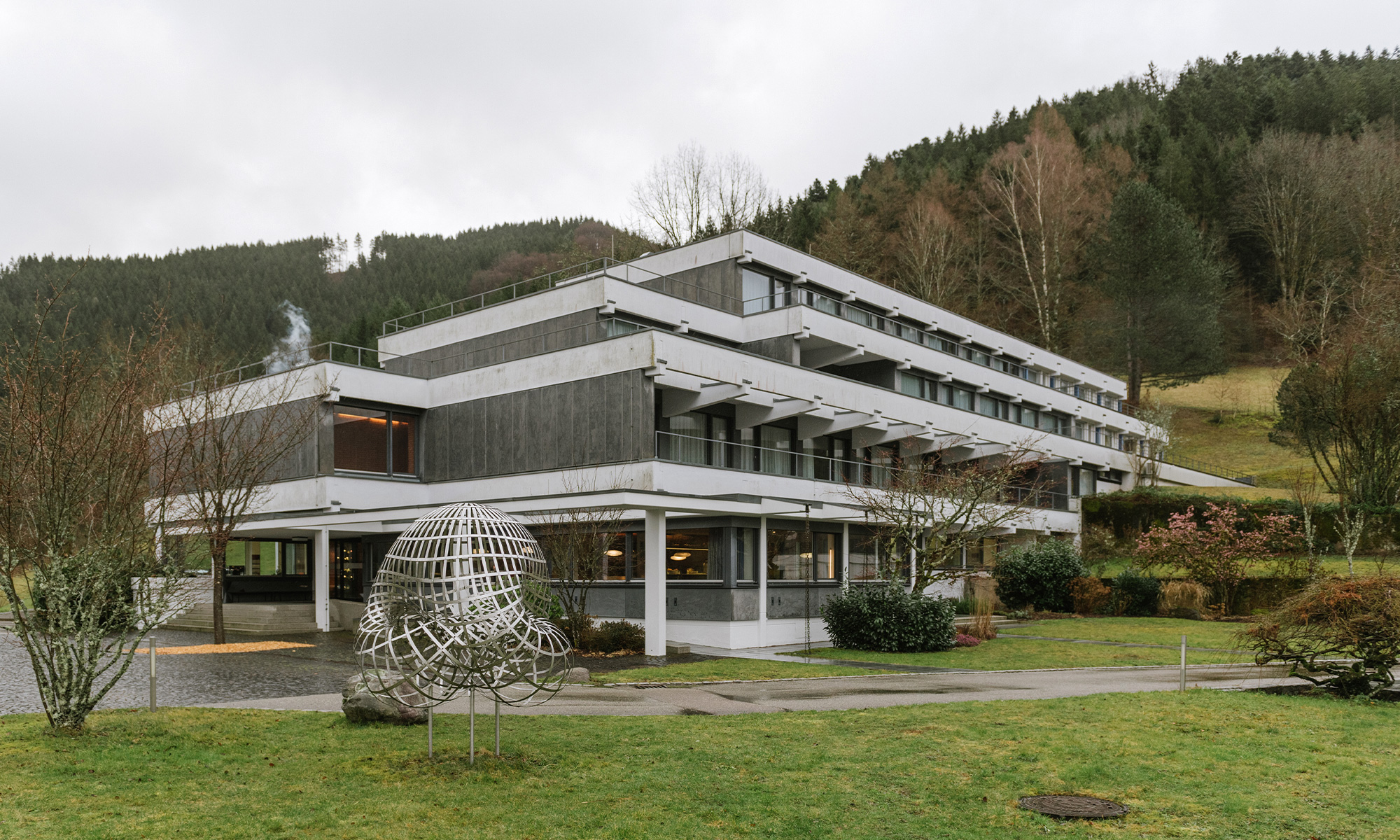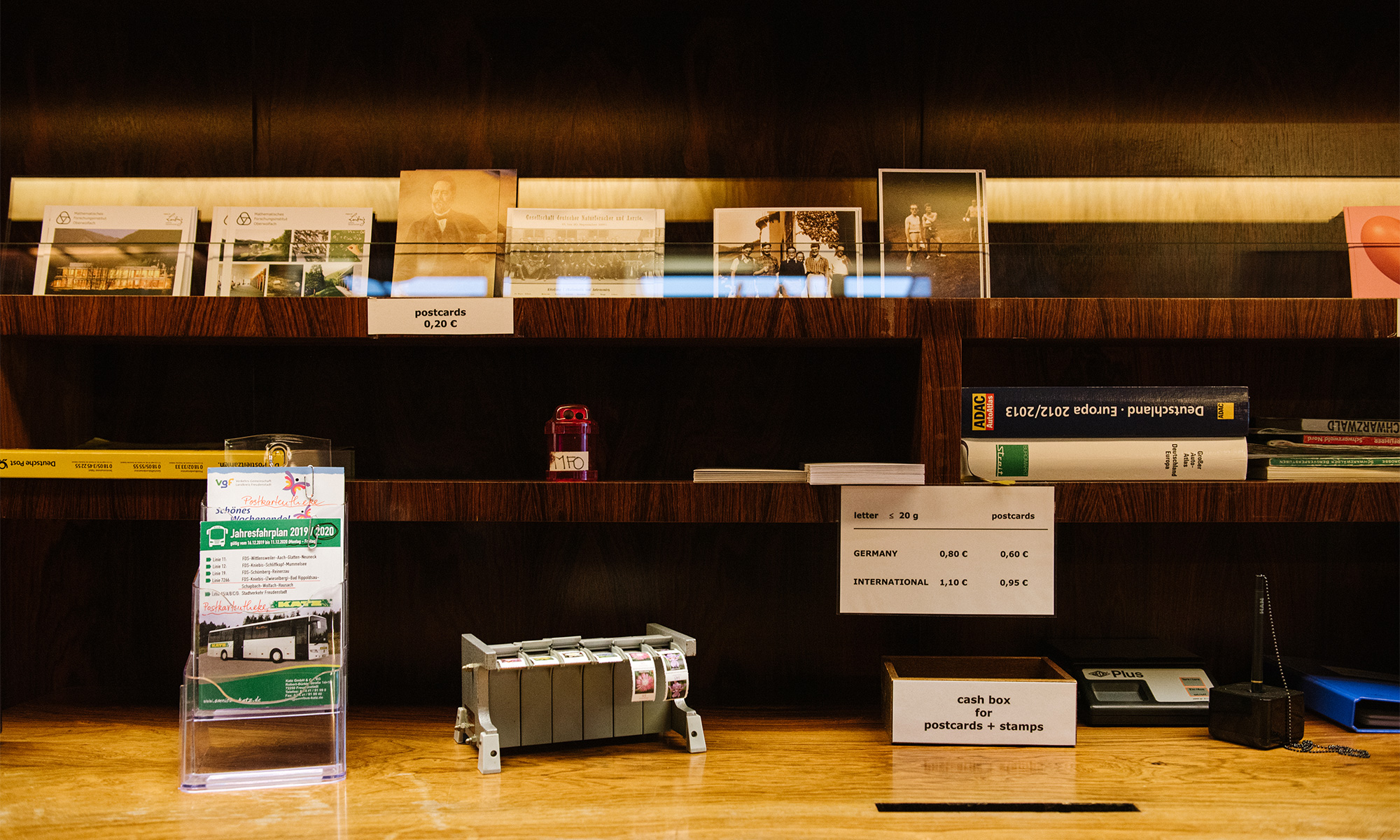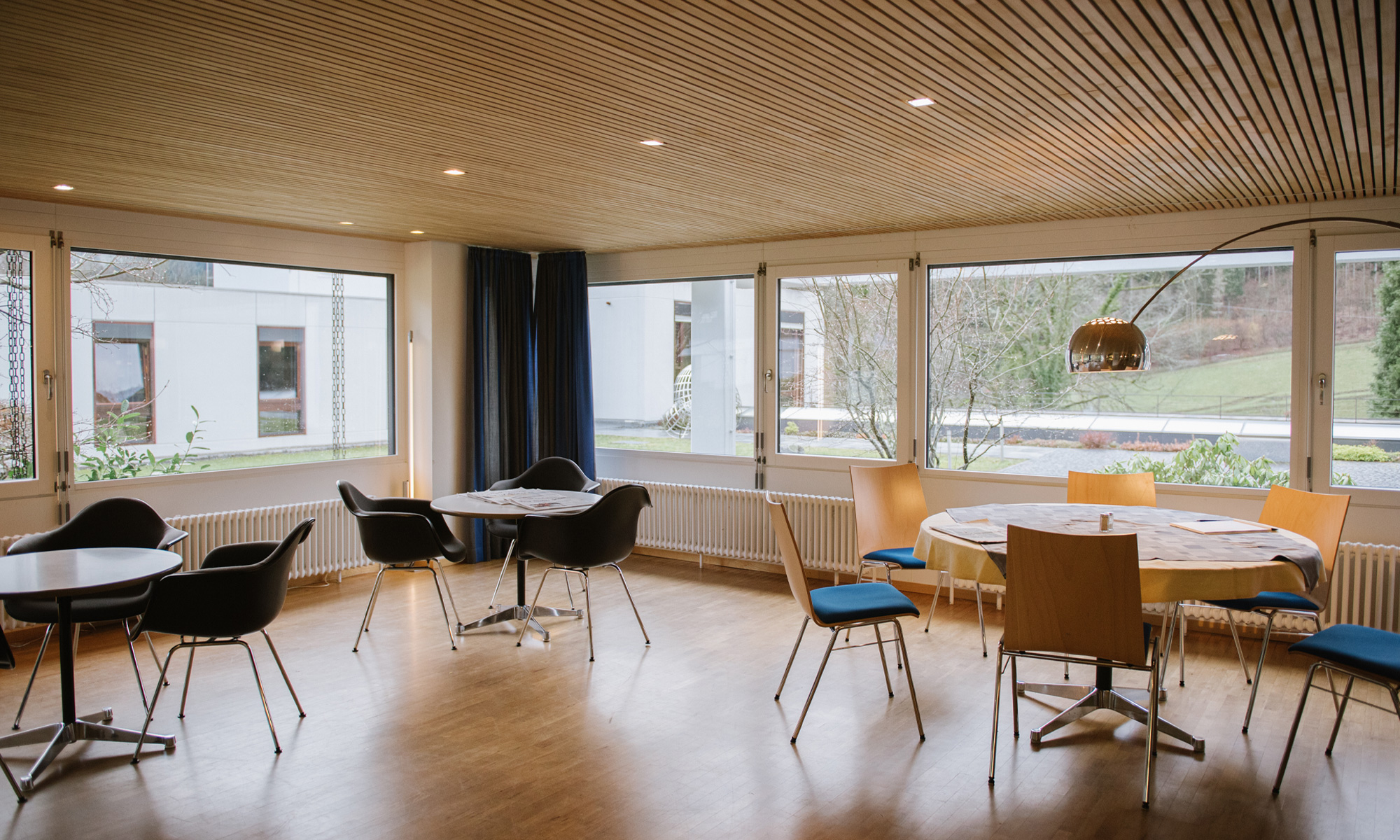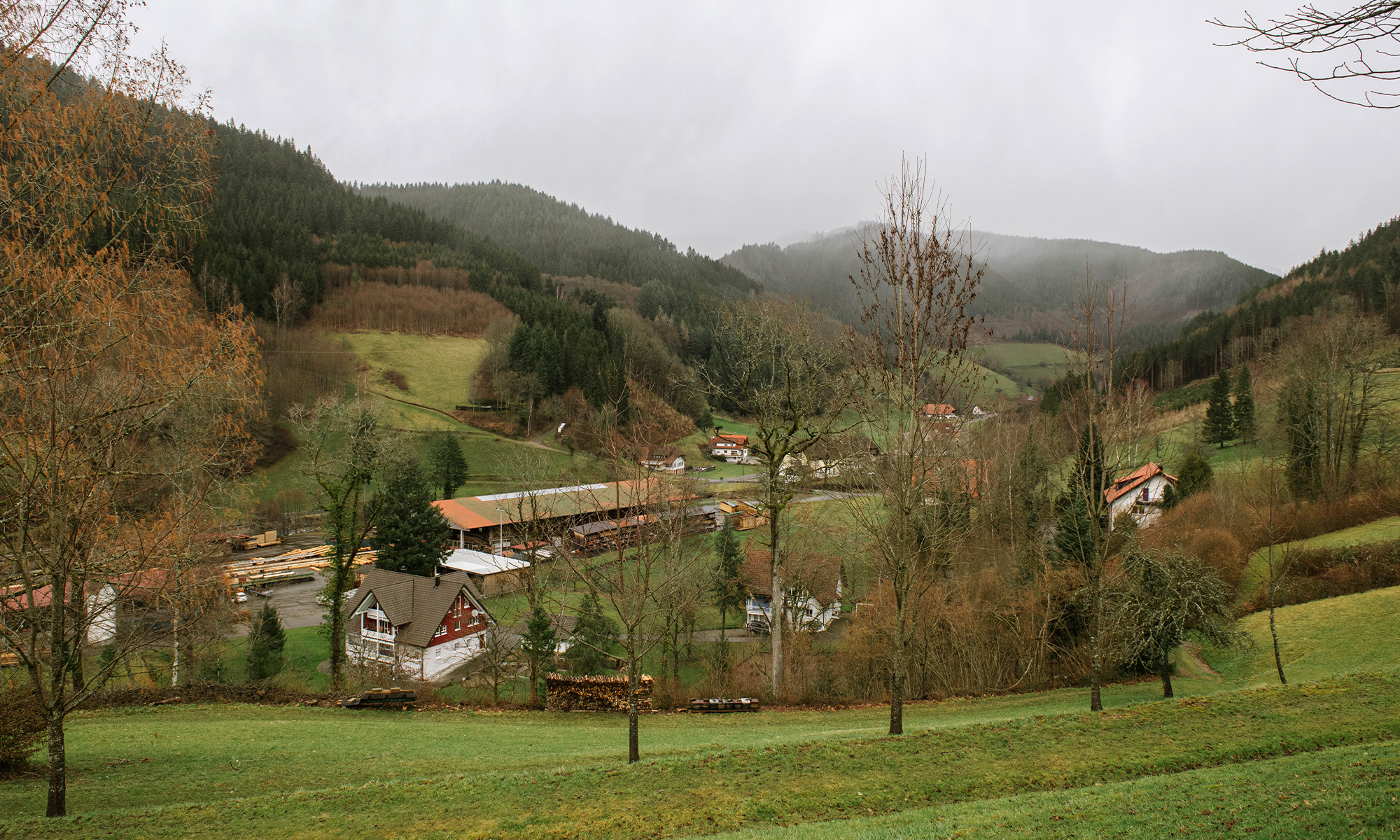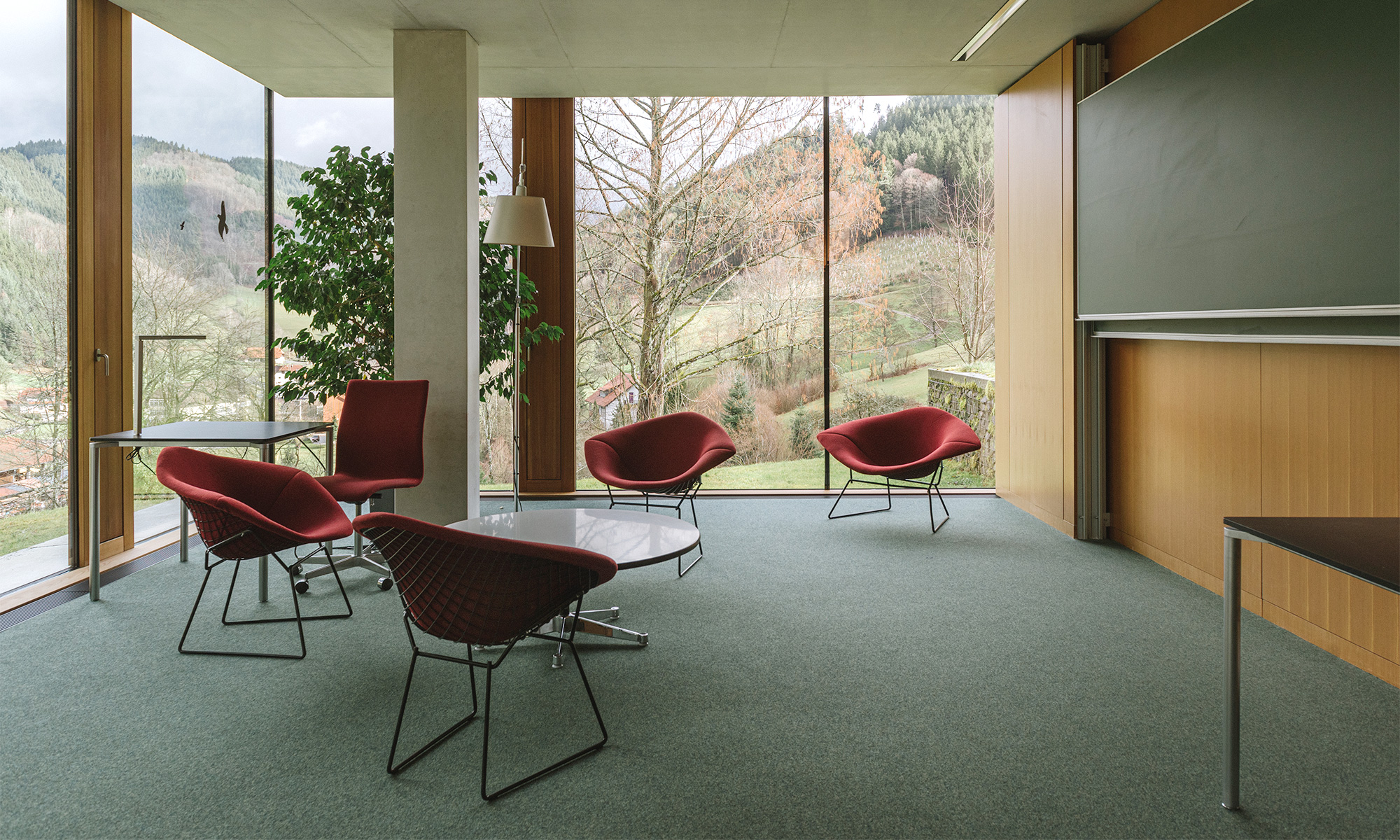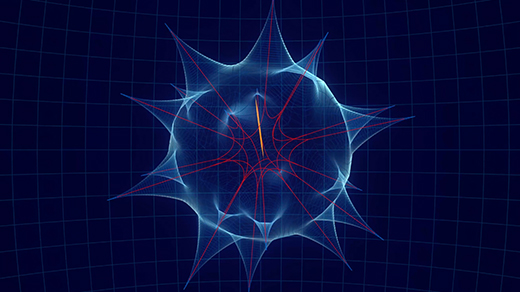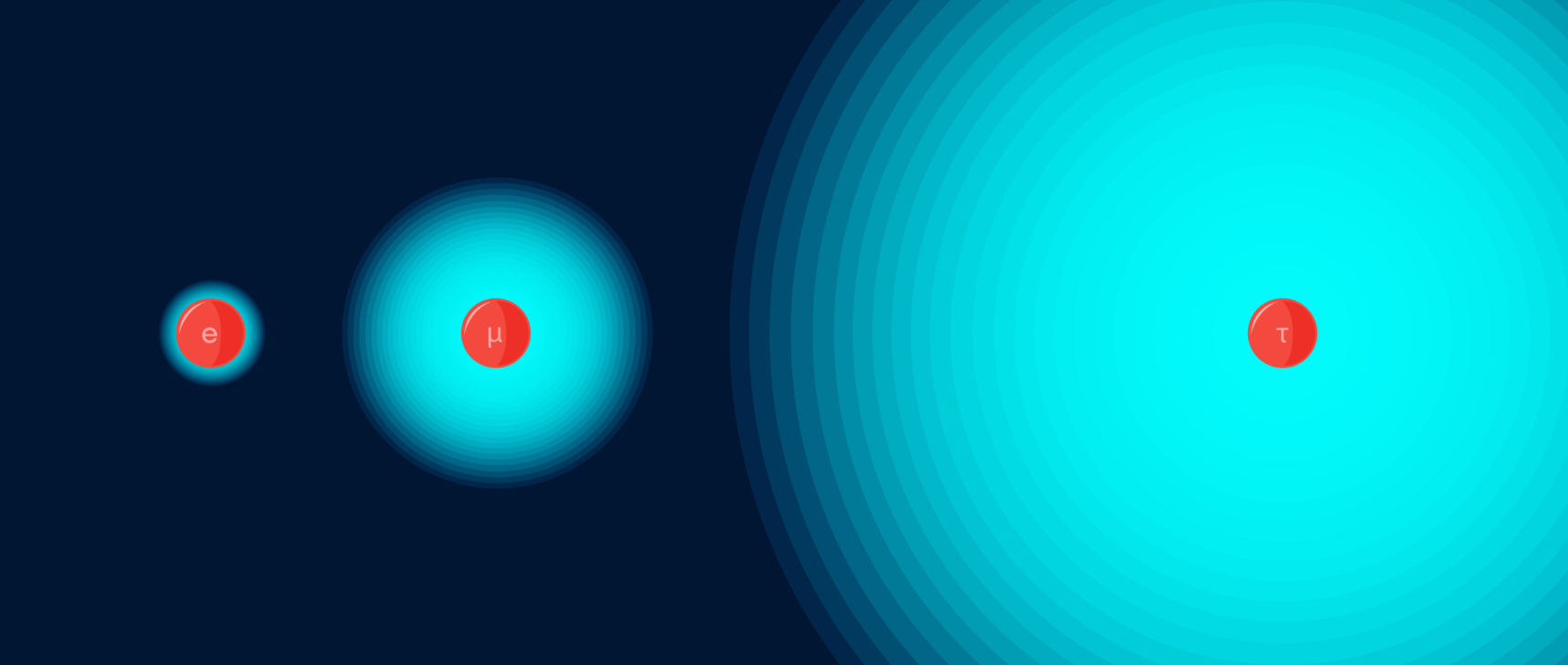Mathematics as a Team Sport
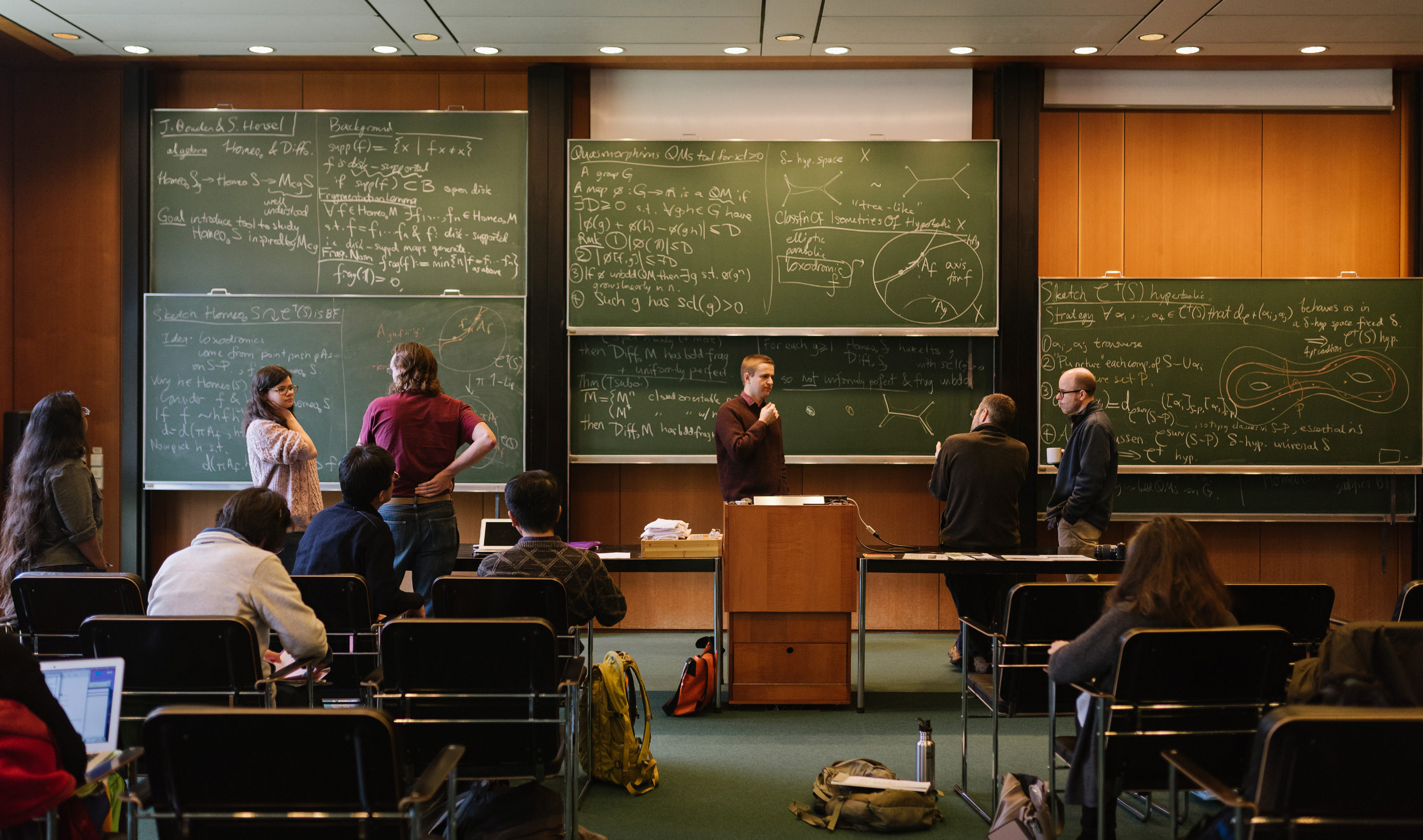
Mathematicians chat following a talk at the Oberwolfach Research Institute for Mathematics.
Thi My Lien Nguyen for Quanta Magazine
Introduction
In February, before the COVID-19 pandemic locked down cities and closed borders, I spent four days with about 50 mathematicians at the Oberwolfach Research Institute for Mathematics in the Black Forest of southern Germany. Most weeks of the year the institute hosts small gatherings focused on different areas of mathematics. I planned to insinuate myself among the professional mathematicians: break bread with them, take a far-back seat at their lectures, eavesdrop on their hallway conversations, and try to figure out how a close gathering like this one promotes mathematical discovery.
There’s no easy way to get to Oberwolfach. I arrived on a Monday by the recommended route, which is to fly to Frankfurt, then take a two-hour train trip south to the hamlet of Wolfach, then a 30-minute cash-only taxi ride along the river Wolf. Eventually I spied the institute itself, perched midway up a steep hill and backed by an expanse of evergreen forest.
Remoteness is the point.
The institute itself comprises several low, windowed, rectangular buildings connected by paved footpaths. It feels built into the surrounding hills. After paying the taxi driver, I entered the front hallway of the bright main building.
An open staircase in front of me led up to efficient, dorm-style accommodations. To my right was a dining room, empty and quiet in the late-afternoon sunlight. I walked over to a small rack of postcards set along one wall and picked one up. It was a black-and-white snapshot from the 1950s: mathematicians milling about as if at camp, wearing horn-rimmed glasses and holding cigarettes. Some of them were bare-chested over buckled pants. It was suggestive of summer heat and the forge of new ideas.
Annette Disch came out of the institute’s office to meet me. She’d been working reception at Oberwolfach for more than half of the institute’s 76-year history, she later told me, hinting that if I took too long to return, I might not find her there. “Because … you’ll be retired?” I guessed. Her eyes twinkled in reply.
But for now it was just business as usual. The mathematicians were all next door listening to afternoon talks, she told me. The next one started in 25 minutes. Dinner was at 6:30 p.m. I was in Room 212. When I hesitated to leave, she knew why. “We don’t have keys at Oberwolfach,” she said. “But you can lock your door from the inside at night.”
Intentional serendipity is a motif at Oberwolfach. The institute works to minimize distractions from math and to remove any barriers to collaboration. No locks, restricted Wi-Fi, and meals served family style with seats assigned at random before lunch and dinner.
“They don’t want the same three friends to always talk to one another,” Stefan Friedl, a professor at the University of Regensburg and one of the organizers of that week’s event, had told me two weeks earlier. “They want to force people to talk to people they might not know yet.”
The institute also serves cake every afternoon except on Wednesday, when the group takes a hike over dirt roads into the village of Oberwolfach Kirche for Schwarzwälder Kirschtorte (Black Forest cake), a chocolate specialty of the region. And, of course, there’s booze. The dining hall features a refrigerator full of tall bottles of German beer, a barrel of red wine on tap, and schnapps for 1 euro a pour, all self-serve and on the honor system. Place your coin in the box.
Topology 101
The theme of the week’s get-together was low-dimensional topology, which despite the name is an easy subject for the uninitiated to approach, as far as advanced math goes.
A line is a one-dimensional shape. The xy-plane is two-dimensional. A billiard ball is three-dimensional. You probably already knew this. “Low-dimensional” refers to shapes like that, up to and including the fourth dimension. If you can’t picture a four-dimensional shape, don’t worry; most mathematicians can’t either.
“Topology” means you’re interested in only certain properties of a shape. You don’t care about its angles, lengths or number of sides. Those are preoccupations of the closely related field of geometry. Instead, topologists investigate questions like whether a shape has a hole in it, and if so, how many. They also ask which shapes can be transformed into others, as if they’re manipulating (but never cutting or tearing) roundish balls of play dough.
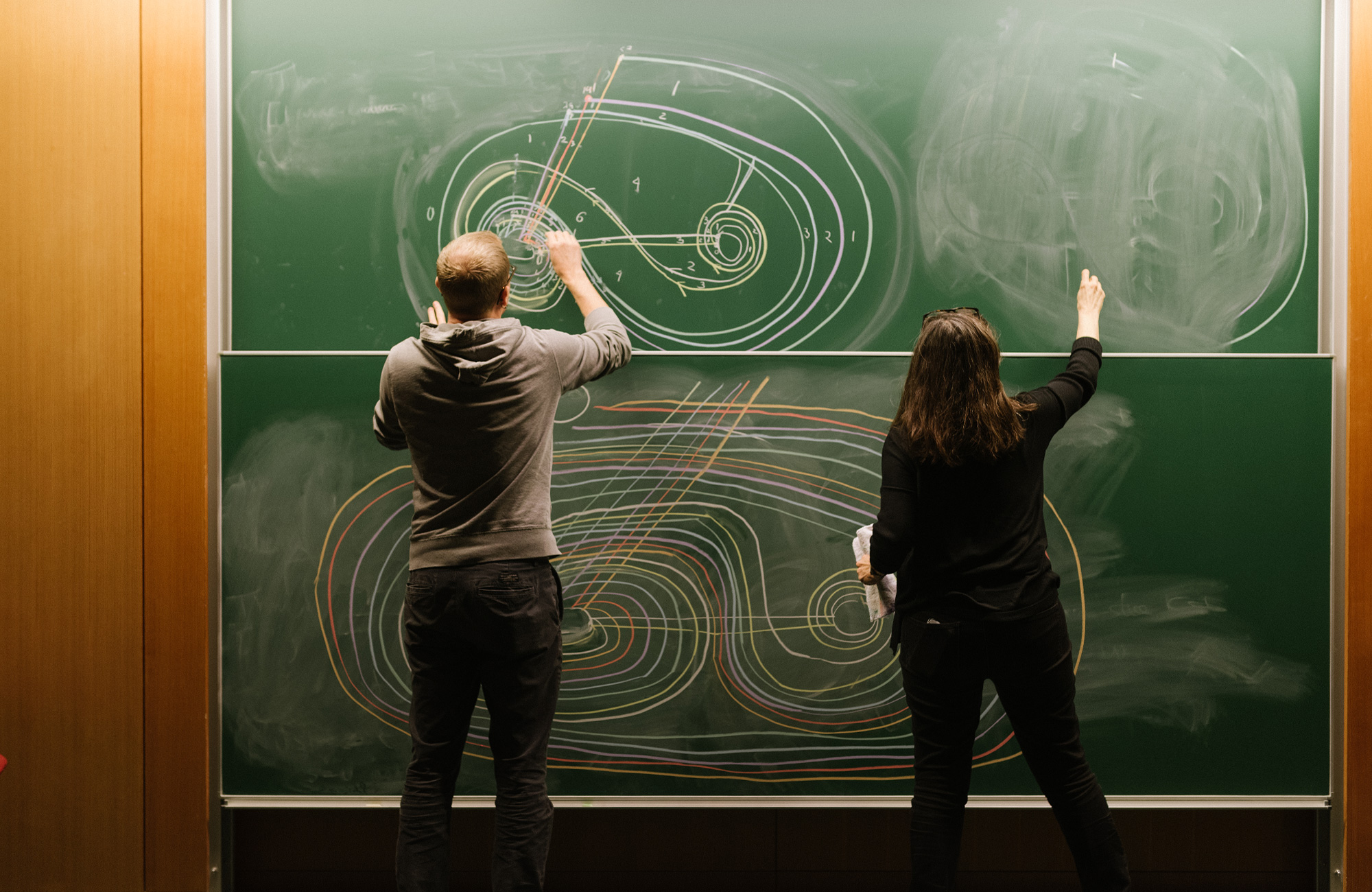
Jeremy Van Horn-Morris of the University of Arkansas and Gordana Matic of the University of Georgia have been working together for years on a problem about the structure of three-dimensional manifolds.
Thi My Lien Nguyen for Quanta Magazine
Oh, and topologists don’t call them shapes. They call them manifolds, a term with a distinct and precise meaning. But if it’s easier for you to think “shapes” when you hear “manifolds,” go ahead.
The most celebrated result in topology over the last 40 years was a proof in 2003 by Grigori Perelman that all three-dimensional shapes without a hole in them are equivalent to a sphere. An ice cube, a dinner plate, a pomegranate — in topology, they’re all the same.
The first talk I saw, the afternoon I arrived, was by Mark Powell of Durham University, who spoke in a lecture room in the library building, next door to the dining hall. The room’s main feature was a set of six sliding blackboards. After Powell filled up one blackboard, he moved it up and out of the way, keeping it visible while continuing on an empty one.
Powell was athletic-looking, with a shaved head and a polo shirt that fit snugly around his biceps. He gave an overview of the state of progress in four-dimensional topology — the next dimension up from Perelman’s work. In short, he said, there was a lot left to do. Mathematicians had only the scantest idea how to identify even the most basic four-dimensional manifolds, let alone how to distinguish and classify them all, the ultimate goal.
“We don’t even know how to recognize the four-sphere,” he said.
Powell discussed five open problems in four-dimensional topology. They included the Schoenflies conjecture, about how the three-dimensional sphere sits inside the four-dimensional sphere, and the “unknotting problem.” Mathematicians know the answers to these problems for manifolds of every dimension except four.
By highlighting these problems, Powell was getting at maybe the biggest difference between the way mathematicians and non-mathematicians see the subject. To the latter group, mathematics feels settled. “What else is there to figure out?” is a common response when I tell someone I’m a math reporter. But to mathematicians, it’s just the opposite. They think of math as an unknown continent we’ve only just begun to explore, with landing parties here and there along the coast and a small number of successful excursions into the interior.
It’s not surprising that as you beat a path inland under such forbidding conditions, you might want to take a buddy with you.
Mealtime
At lunch on Tuesday — the day I turned 39 — I sat next to Priyam Patel, a young mathematician from the University of Utah. She had big eyes and was bright and effusive.
As we passed plates of schnitzel and salad, Priyam told me that almost every paper she’d written had been a joint work with other mathematicians. This was rare in mathematics a generation ago, but it’s the norm today.
“If you look at the average math paper in 1920 compared to the average math paper published in 2020, the average number of authors has grown dramatically,” David Futer of Temple University, one of the workshop participants, told me.
There are lots of reasons for the shift. Technology makes collaboration easier than ever, of course. There’s also just much more mathematics to know than there used to be. It’s a good idea to have many minds gathered around the table, all of whom have a slightly (or sometimes vastly) different library of knowledge to draw on. That is the premise of spending a week at Oberwolfach — and at a handful of other institutes around the world that are modeled on it, including the Banff International Research Station in Canada and Casa Matemática Oaxaca in Mexico.
“You take 50 people who hopefully are smart and close enough mathematically that they can talk to one another, but different enough that they [have unique ideas],” Friedl had told me. Together, they may have explored enough different places in that undiscovered continent to map out a region.
Priyam was eager to start. She’d heard a talk the previous morning by Katie Vokes of the Institute of Advanced Scientific Studies in France. Vokes had described a test she’d developed for telling when certain kinds of manifolds have a certain kind of property. Specifically, the test determined when graphs associated with “finite-type surfaces” are “hyperbolic.”
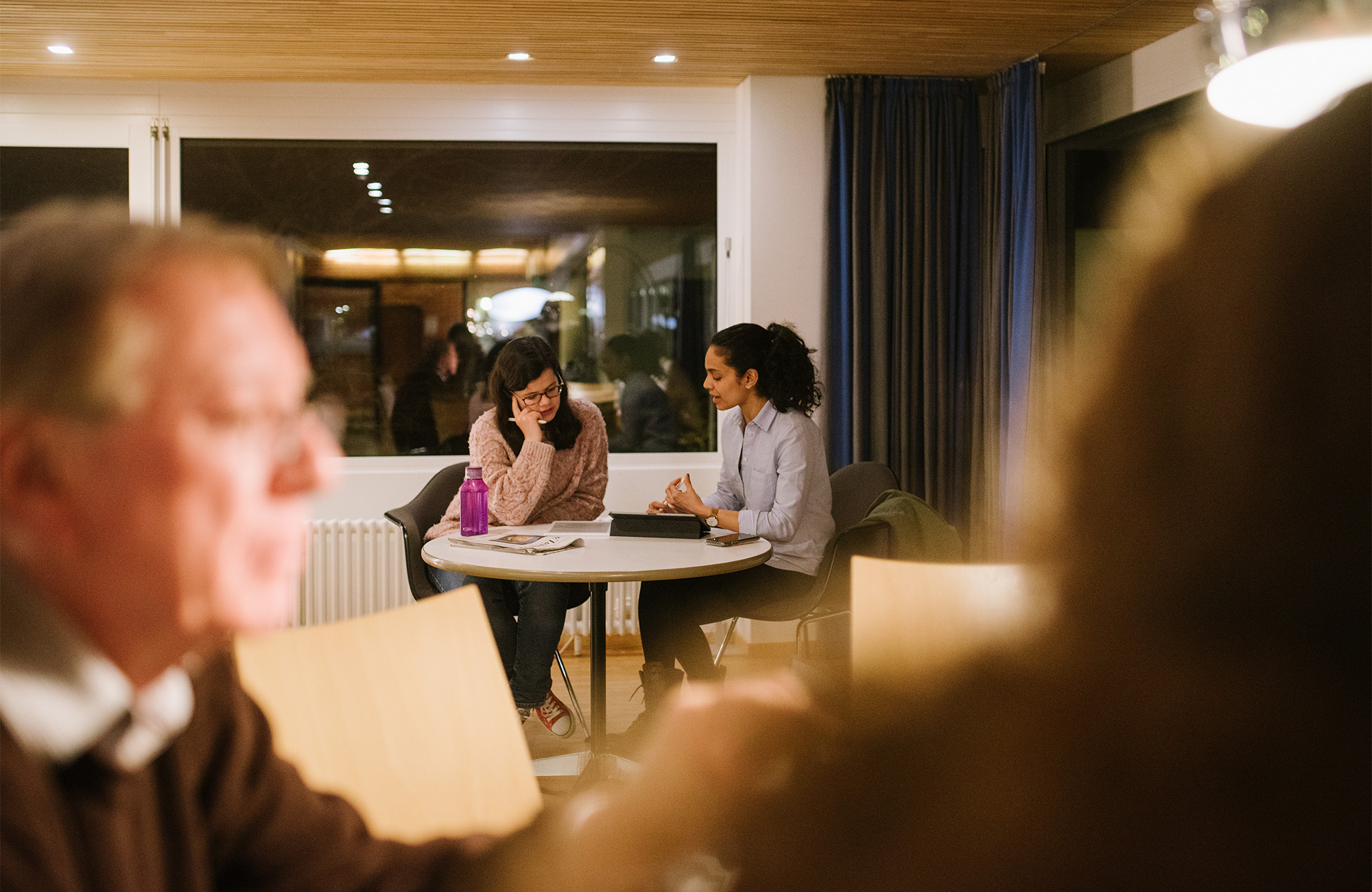
Katie Vokes of the Institute of Advanced Scientific Studies and Priyam Patel of the University of Utah begin a new collaboration following dinner on Wednesday night.
Thi My Lien Nguyen for Quanta Magazine
Priyam studies closely related shapes (infinite-type surfaces), and she wanted to figure out whether she could adapt Katie’s test to her own work. Priyam said she planned to talk with Katie one evening after dinner. I asked if I could listen in. She was taken aback by my request.
“When people are talking about math, they don’t always want other people around. You’re in a very vulnerable place,” Priyam said. “You just let your ideas flow.”
Nevertheless, she agreed to find me before she and Katie got to work.
Building a Treehouse
After lunch, I went looking for mathematicians to observe. On the second floor I found Autumn Kent and Yair Minsky seated close together at a low table. I asked if I could join them. They agreed in the manner of someone who doesn’t really want to share a sip of their lemonade, but can’t find a courteous way to say no.
Autumn, from the University of Wisconsin, Madison, has dyed-blond bangs and traces of a Carolina twang. I knew her name from a widely circulated interview she gave a few years ago on being a trans woman in mathematics. Yair, of Yale University, is a recent empty nester with a graying beard and a gentle bearing.
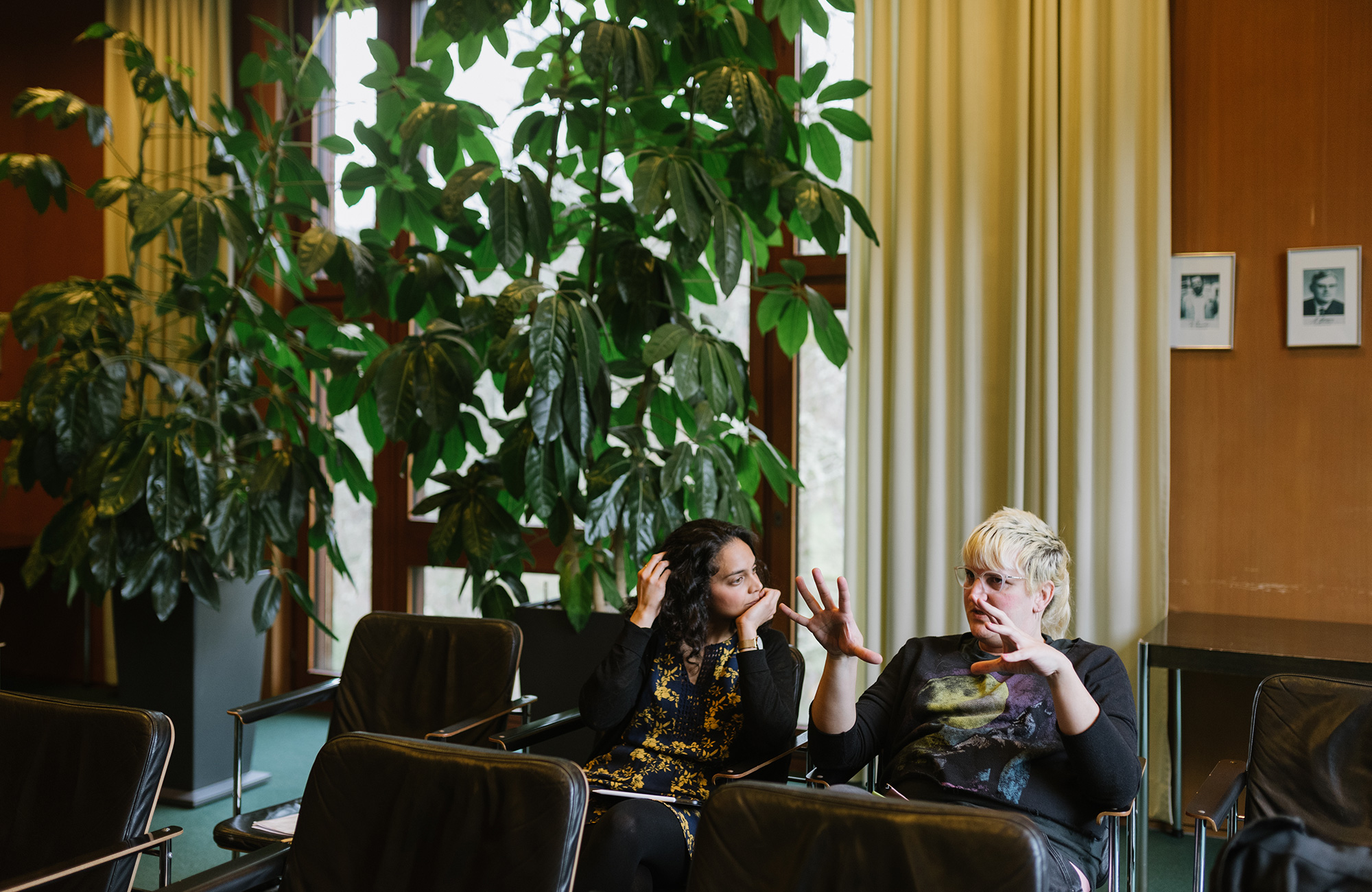
Patel talks with Autumn Kent of the University of Wisconsin, Madison.
Thi My Lien Nguyen for Quanta Magazine
The topic of conversation was a problem about gluing together three-dimensional manifolds the way you’d glue together two blocks. To make the gluing work, you have to deform the boundaries of the manifolds so that they fit together. Autumn and Yair were trying to understand how this deformation could change a manifold’s other properties.
Autumn had a pencil and a pad of paper. She sketched shapes the way you might start to design a tool, talking as she went.
“Do we need to assume the x naught is thick?” she asked.
“We must,” Yair replied.
I imagined that instead of discussing mathematics the pair were building a treehouse. They had a shared knowledge of construction techniques but had also learned different lessons on their separate building projects. Plus, they were different by disposition. Yair exhibited more of a measure-twice-and-cut-once attitude, while Autumn, with her pencil poised, seemed ready to start hammering.
“You don’t have a hyperbolic manifold anyway, so you might as well screw it up before you drill,” she said.
They broke the construction project into parts: how to site it, which materials to use, that kind of thing. At the moment, they were working on controlling how the deformation process made the volume of certain areas within the manifolds increase. If they couldn’t control the volume, they’d have to find another way to attack the problem. In other words, they’d picked out a kind of material they wanted to use for the treehouse floor, but it might be too heavy for the design to support.
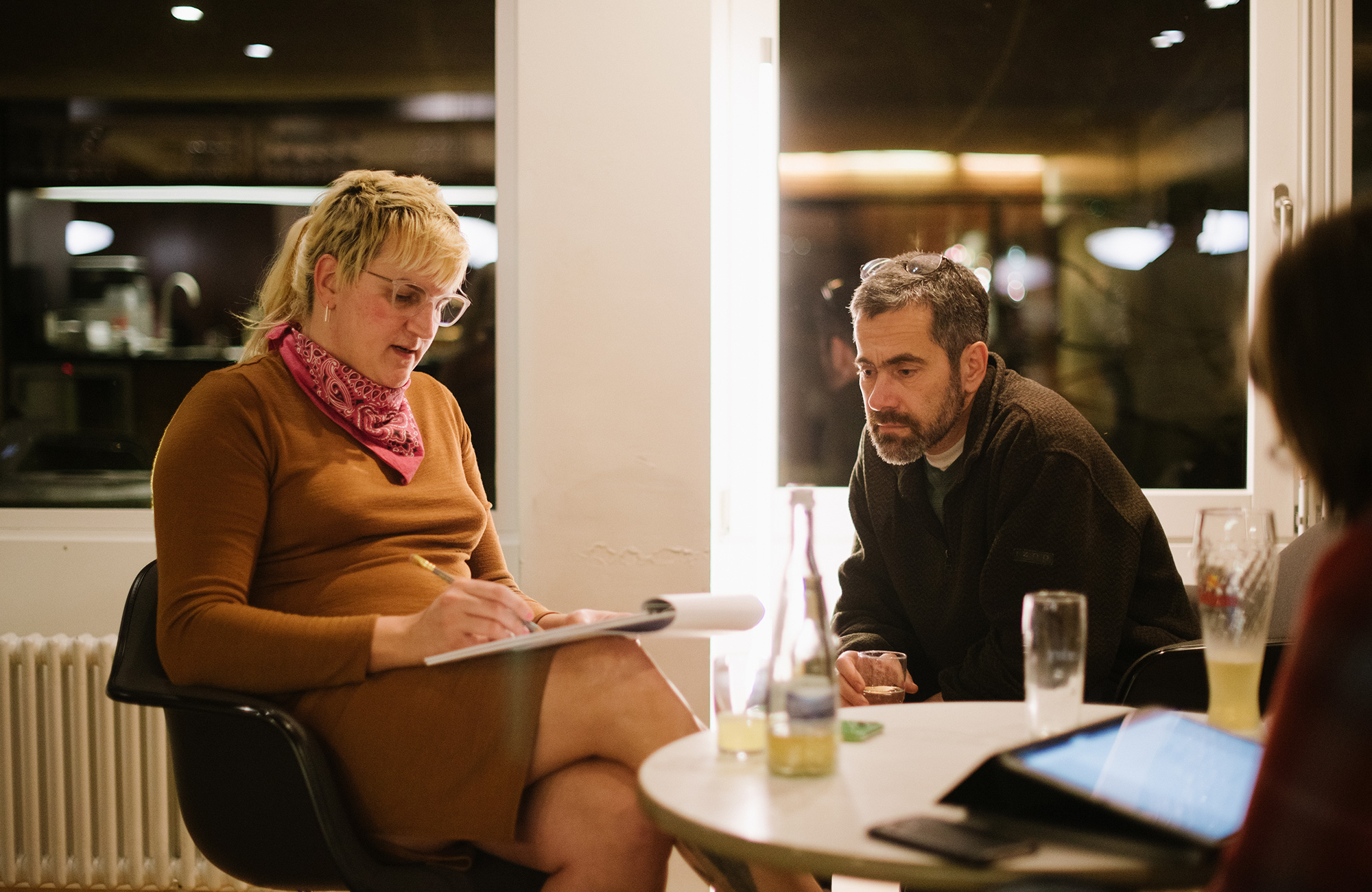
Kent and Yair Minsky of Yale University used their time at Oberwolfach to continue a years-long collaboration on a problem involving gluing together three-dimensional manifolds.
Thi My Lien Nguyen for Quanta Magazine
Yair thought for a moment. Finally he said, “So I think I have three points. One point of agreement and two points of contention.”
The most striking thing about Autumn and Yair was not their arcane vocabulary or Autumn’s glyphs. It was the way they related to each other. Many of us talk and listen with divided attention. But mathematicians, when they’re talking about math, listen with a depth of attention that I’ve almost never seen one person give another. They listen as if they’re exploring dangerous new terrain and their lives depend on understanding each other.
Speed Dating
Later that Tuesday afternoon was the week’s first round of “five-minute talks.” It was effectively speed dating for mathematical ideas.
Twelve mathematicians had five minutes each to present their research. The time limit was strictly enforced. Saul Schleimer of the University of Warwick, one of the workshop organizers — long hair, jeans, hiking boots — sat in the front row with a countdown timer displayed full screen on an iPad. Friedl, wearing trail sandals and a baggy white T-shirt, sat beside him with a pan and a metal spoon that he’d bang together to chase long-winded mathematicians offstage.
Mathematics may be abstract, but math talks are very physical. The mathematicians spoke quickly, nearly transcribing themselves in chalk as they went. If they wrote a lambda when they meant an alpha, they’d erase the errant marks with their hands rather than pause to retrieve an eraser cloth. They raised and lowered heavy blackboards that didn’t always stay where they were supposed to.
The style of presentation was deliberate. Chalk, blackboards and the real-time reproduction of ideas convey cognitive benefits. Even for experts, mathematics is hard to absorb on the fly. It takes time to process an idea and see how it connects to the next one, and to the main idea mentioned 15 minutes earlier. Writing as they go forces speakers to slow down, which makes them less likely to swamp the audience with information. And by displaying the whole line of mathematical argument on adjacent blackboards, the speaker allows people in the room to review earlier parts of the talk at a glance.
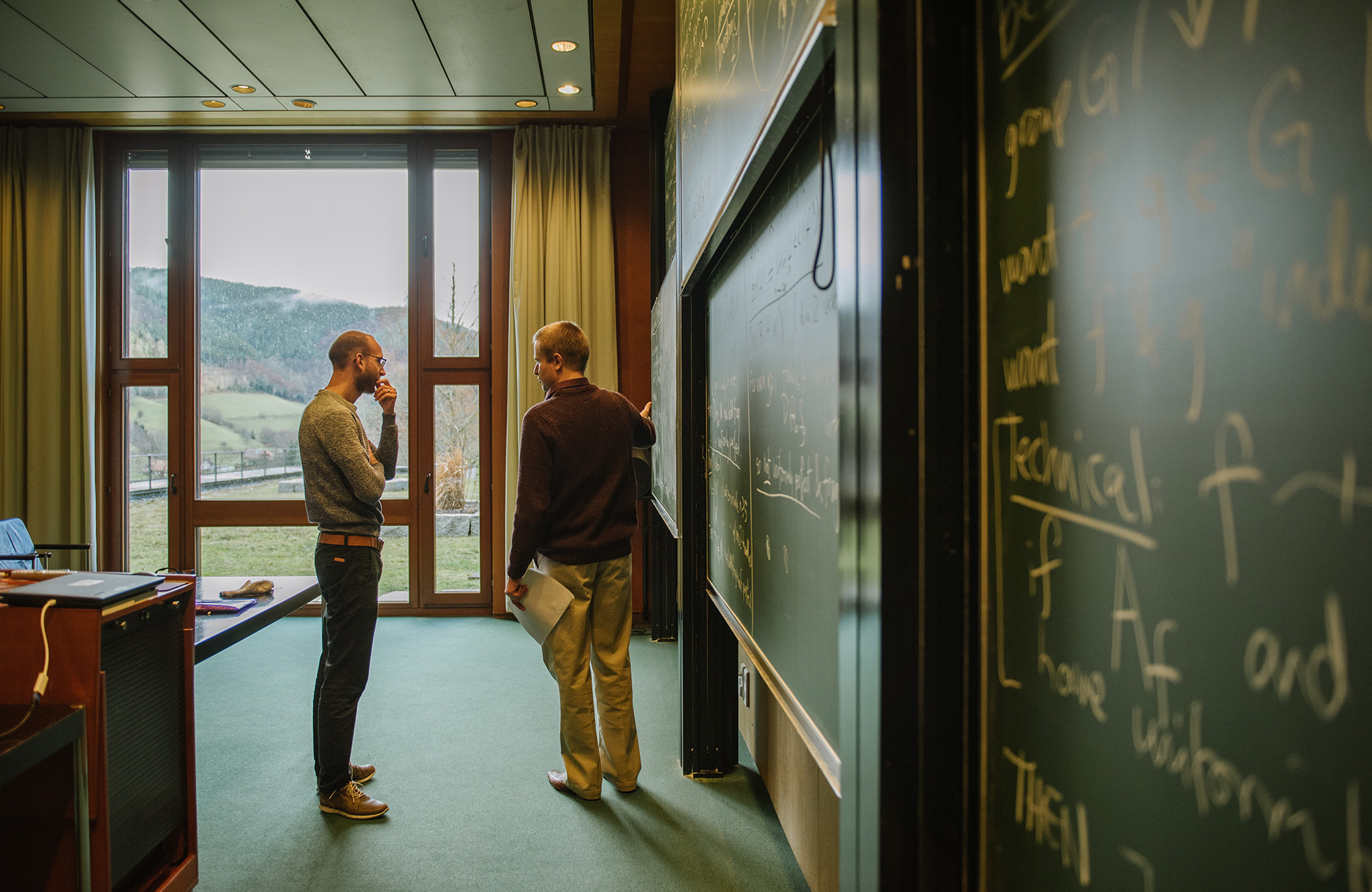
Markus Land of the University of Regensburg asks Richard Webb of the University of Manchester a question following Webb’s talk.
Thi My Lien Nguyen for Quanta Magazine
The communion between a speaker and an audience in a math talk is intense — similar to the way Autumn and Yair related to each other, but with more of an edge.
As the presenters unspooled rows of symbols, it felt at times like they might have been putting us all on. Whole sentences would pass with barely a recognizable word. You’d be forgiven for thinking, as I might have once or twice, that the whole thing was gibberish. But then during one of the talks the mathematicians around me started to shift in their seats. From other parts of the room I heard noises like the sounds of a pack coming to attention. Finally, someone raised their hand and said it: “Shouldn’t that be a greater-than sign, not a less-than sign?” pointing to the offending symbol on the blackboard.
The speaker, startled, found the mistake, erased it swiftly, and continued. Clearly, there was an underlying order to it all that everyone else was following.
Cooking Without Eggs
Wednesday morning a storm moved in. Hail skittered across the paved walkways outside. Later it snowed, a brief wind-whipped whiteout. The organizers decided to postpone the ritual hike by a day.
After another day of lectures and five-minute talks, the mood that night grew festive. Some people sat in groups of two or three, chatting. At one table, Henry Segerman of Oklahoma State University was displaying his collection of 3D-printed topological shapes. He’d been on sabbatical from his teaching job for the last seven months and on the road the whole time, traveling between workshops and friends’ guest beds, his math toys in tow.
The center of gravity in the room was a full table, mostly graduate students and younger professors, playing a cooperative card game called The Mind that generated frequent moments of hysterical laughter. Friedl had promised me over Skype that the week would feel like a family get-together. That had been hard for me to imagine. Now I was seeing it.
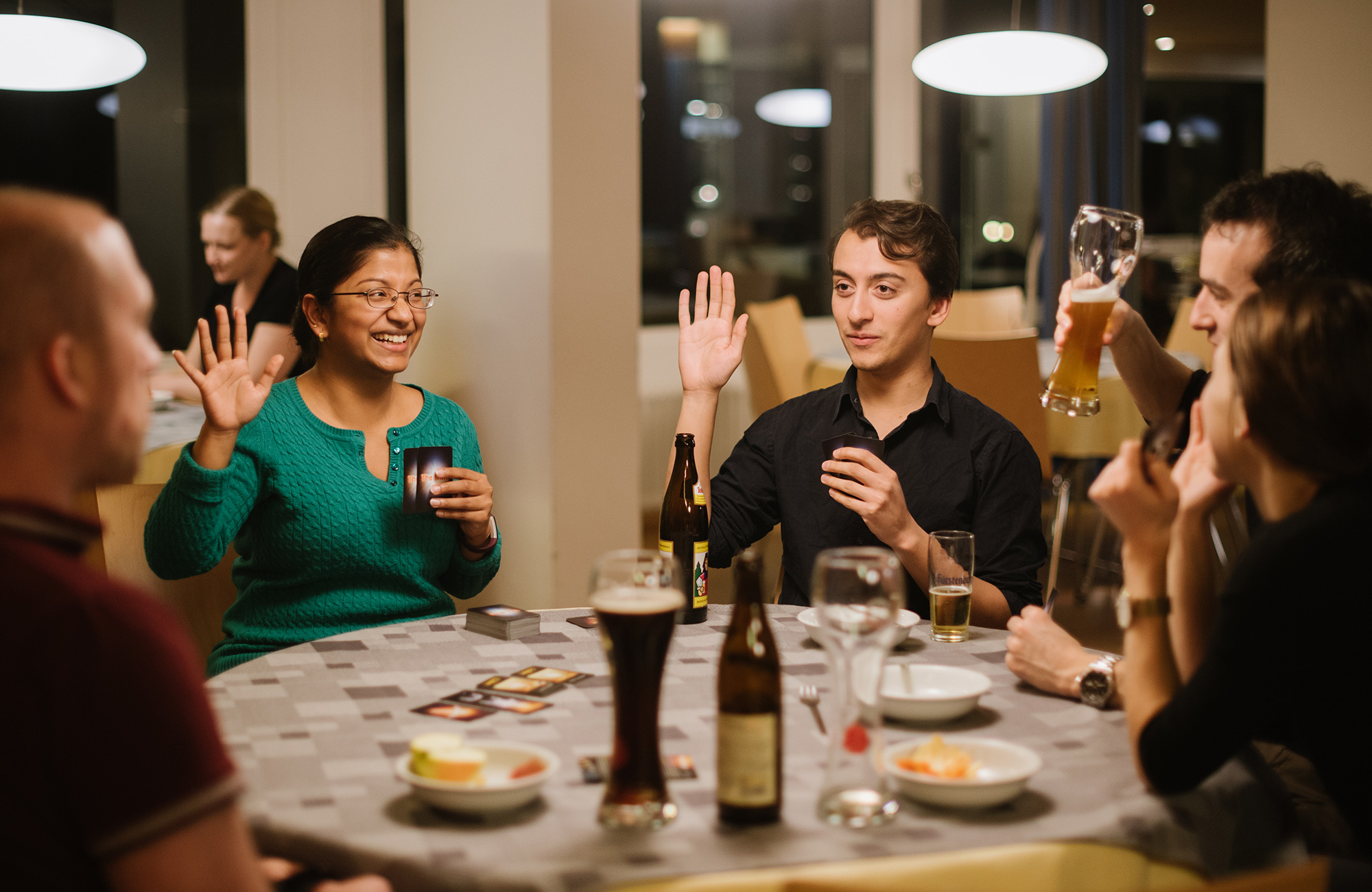
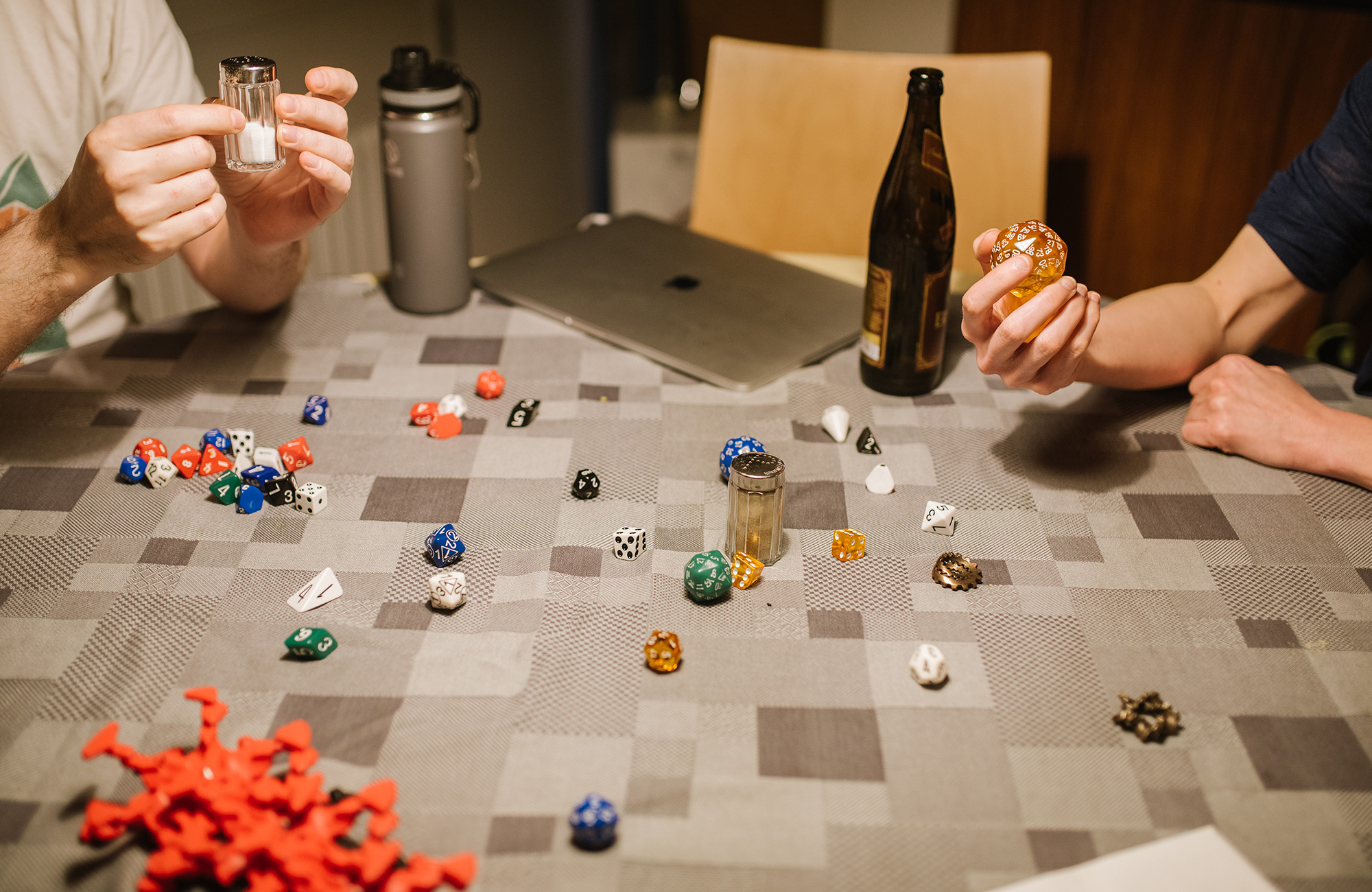
After a day of talks, the mathematicians at Oberwolfach unwound with drinks and games.
Thi My Lien Nguyen for Quanta Magazine
Priyam found me and said she and Katie were about to start. I got my notebook and a bottle of Pilsner and pulled up a chair to watch.
Priyam hoped to import Katie’s test — for detecting when graphs are hyperbolic — to her preferred mathematical setting, the study of infinite-type surfaces. Transplanting an effective technique into a different environment like this is a common way new mathematics gets made. To do it, mathematicians need to understand what, fundamentally, makes the technique work. The conditions of the original setting won’t all be present in the new one, but hopefully they won’t all be necessary.
“You have to dig deeper to see what something really relies on,” Priyam told me.
Later in the week I talked again with David Futer, and he arrived at an analogy: Transplanting a mathematical technique is like trying to bake your favorite cake for guests who are allergic to eggs. “You’re hoping that you can still bake the same cake without the eggs,” he said.
Katie wore a thick wool sweater and a serious expression. She knew that in her work, on finite-type surfaces, the hyperbolicity test relied on nine axioms, or conditions. And she had bad news for Priyam: She would have to get by without eggs.
“OK, maybe I’ll just tell you now, the axiom I don’t think works in your situation,” she said.
Priyam didn’t see it yet. “I’m confused about this condition.”
Katie went back a step. “Do you know what a median algebra is? OK.” And she started to explain it. Priyam was encouraged for a moment.
Katie wasn’t so sure. “I’m still a bit worried.” Priyam acknowledged she was, too.
After half an hour they’d at least clarified the picture. Of the nine axioms, they knew for sure that one of them wouldn’t be available to Priyam. Yet even without it, they hoped to prove that a different set of conditions, called the coarse median axioms, still applied. Get those conditions, and you still get the hyperbolicity test.
But whether that was possible was more than they could figure out that night. In the background, another round of laughter shook the center table.
Lost in the Woods
On Thursday afternoon the postponed hike into town for Schwarzwälder Kirschtorte set off, under mostly clear skies. Before we left, Schleimer, the co-organizer, announced that by popular demand there’d be a bonus round of five-minute talks that evening, my last of the event.
About 20 mathematicians went on the outing. We split into two groups: One took the road into town, the other climbed up a forested hill onto logging trails, even though their condition was uncertain following the previous day’s storm. I joined the overland group and fell in beside Anna Parlak, a graduate student at the University of Warwick. We’d talked over Skype before the workshop, but I hadn’t seen much of her since I’d arrived.
Now we walked beneath tall pines down a muddy trail riddled with tire tracks. I searched for drier ground along the trail’s edge while trying to keep up with Anna, who seemed unperturbed by the slop. I told her I’d enjoyed the five-minute talk she gave the afternoon before. She’d mentioned that under particular conditions, two different things — types of polynomial expressions — seemed like they should always be equal. Yet she knew of examples where they weren’t. After the talk another mathematician had asked her to explain why she thought the equality should be inviolable; in answering the question, she realized why it failed.
“Sometimes you don’t ask yourself the correct questions, but people can ask them for you,” she said.
The group paused at an intersection and studied a cluster of trail signs. No one was confident which way to go. Someone made a joke about topologists having a bad sense of direction, which got less traction than in-group jokes sometimes do. Finally a few people started trickling up the leftmost trail, so that’s the way we all went.
I saw Yair up ahead and hurried to catch up with him. I asked how he and Autumn were doing controlling the volume growth in their problem. He said it had been up and down: On Tuesday, when I first sat down with them, they thought they had a way to do it, but by Wednesday they realized it wouldn’t work. He said they were now looking for a new approach, and when I circled back to Autumn later that night she thought they might have found one.
As we started the descent out of the woods, I asked Yair about that baking metaphor with the eggs. He said that, for him, doing math was more like wandering in the fog. Sometimes you get where you want to go; other times, the air clears just enough to confirm that you’re going the wrong way.
Metaphors abound when people talk about doing math. You’re exploring a continent, or building a treehouse, or baking a cake. Or wandering in the fog. That’s partly because the primary experience of high-level mathematics is just about impossible for non-mathematicians to perceive directly. But even among experts, effective communication often requires allusion. Mathematical ideas are subtle and complicated. Expressing those ideas is like trying to put a powerful emotion into words or, to draw yet another analogy, like narrating a dream you’re rapidly forgetting.
“They are these vague, inchoate thoughts that are not even formulated at the level of language,” Futer told me.
Given the difficulty of the communicative task involved in collaborating on new mathematics, it helps to have time together in the woods to sort things out.
Impressions and Next Steps
The Schwarzwälder Kirschtorte was dry, as I heard it would be. But I ate it all. I’d had my fill of the woods, however, so for the return trip I joined the road group. We walked out of town along the river Wolf. The lowering sun glowed off the steep green pastures on the opposite hills. Beyond, the sky was so blue it felt like an overwrought reproduction of our own planet.
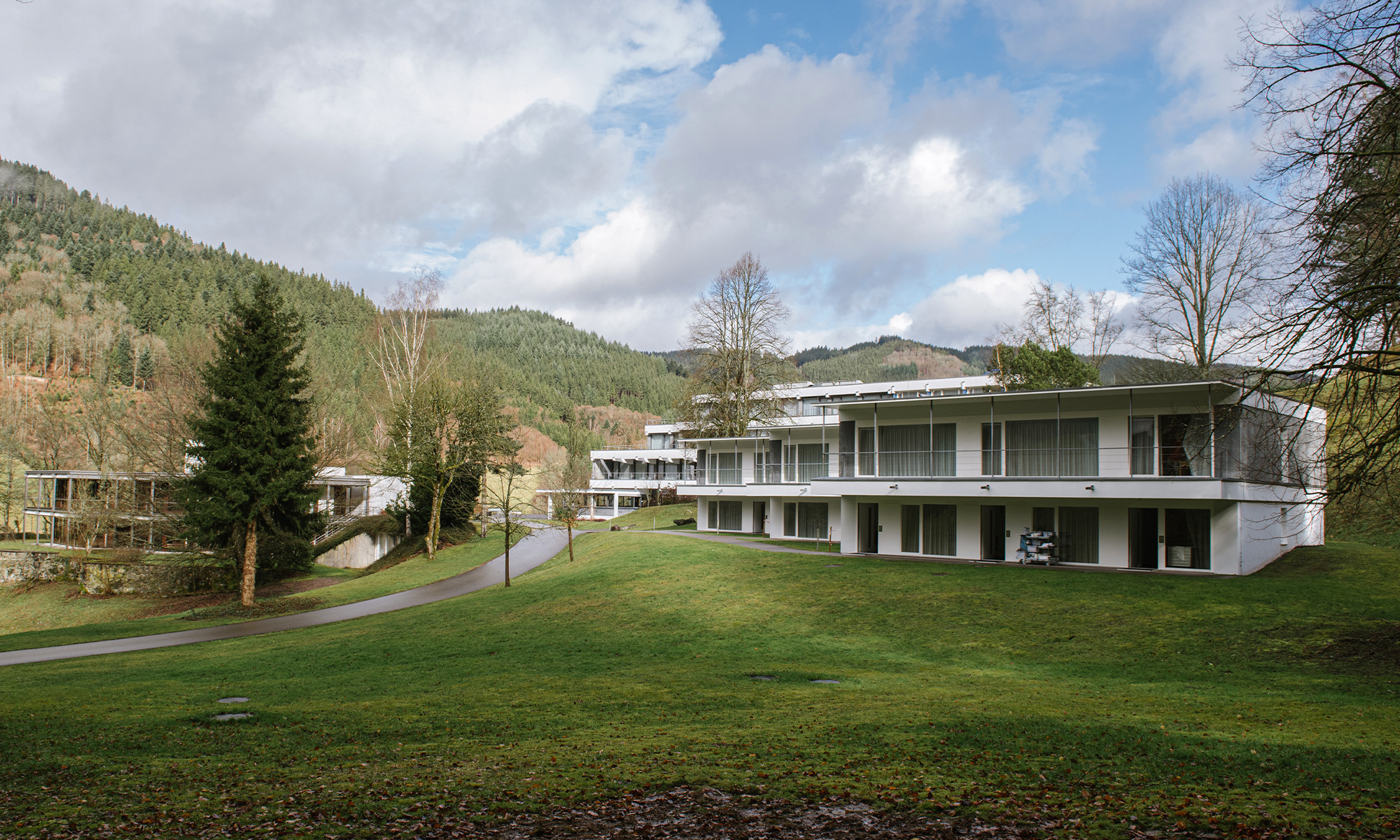
The Oberwolfach campus is remote by design.
Thi My Lien Nguyen for Quanta Magazine
My first couple days at Oberwolfach, every interaction with the mathematicians felt formal, as between strangers who are wary of each other. Yet on the walk home that afternoon I felt that my status in the group had shifted to something like equipment manager on a basketball team — affectionately included, even if still not a real player.
I walked in a group with four mathematicians, including Friedl. We’d reached the point in the week where they wanted to know what I thought of them. I wouldn’t say they were fishing for compliments, but I knew that the topologists thought of themselves as a fun group. One of them had told me, in case the comparison might help me contextualize my visit, that he’d heard that when number theorists visit Oberwolfach, the place feels like a morgue.
I said, yes, I was having a good time. Then I hesitated, not sure whether to complete the thought. But we’d started to feel like friends, so I did. “I think most people have the wrong idea about what mathematicians are like,” I said.
“What do people think?” asked Richard Webb of the University of Manchester, who had given what was widely regarded as one of the week’s clearest talks the day before. I couldn’t tell if Webb was unaware of the stereotype or merely asking me to spell it out.
“You know,” I ventured: “that mathematicians can’t talk to other people.”
Webb considered this seriously, and I couldn’t tell whether it surprised him or not. Finally, he said, “I think that was more true among undergraduate [math majors]. But math is like everything else: To be successful you have to be able to communicate.”
That night, everyone gathered in the lecture room for the extra round of five-minute talks. The frying pan and spoon were back, but the room felt different, more exciting, like returning to your middle school gym after dark for a dance. Word got out that tonight, speakers would have to keep a drink in their hands as they talked. Up front, next to the eraser cloths and chalk, Futer uncorked a bottle of red wine and set up a row of glasses.
Most speakers paid lip service to the drink requirement, but Abigail Thompson of the University of California, Davis, mostly saw it through. She was the last to go, and she talked about some new research building on a recent theorem which proved that all four-dimensional manifolds can be divided into three equal pieces. I made a quick note about how if a new egg substitute came on the market, there’d be a lot of new cakes you could bake.
When the chalk dust settled, no one wanted to leave. One mathematician ran next door and came back with two more bottles of wine. People grabbed chairs and talked in small groups. Someone commandeered a laptop that had been used for one of the five-minute talks and projected ABBA videos on the overhead screen.
I found a seat with a few others in the back of the room. A lot of us were leaving the next day, and talk turned to home: flights back to Salt Lake City and Miami, trains to Berlin, the desire to squeeze in some time with kids before the workweek recommenced on Monday.
I thought of Anna, who now knew why her presumed equality didn’t hold, and Yair and Autumn, who’d at least ruled out one dead end in their attempt to glue together manifolds and had maybe opened up another path forward. And I thought of Priyam and Katie, who had plans to reconvene on Skype a few weeks later to see if they could make that hyperbolicity test work.
Finally, I got up to leave. “I can top you off,” a mathematician said, gesturing in my direction with a bottle. But, no, there would be a taxi waiting for me before dawn.
In the last days before such in-person gatherings would become unthinkable, I’d seen mathematicians converge in the woods in Germany and talk late around a table so close together that their knees touched. Math problems may have only one answer, but it often takes conversations among many minds to find them. And now, after a week at Oberwolfach, there was more math in the world than there used to be.
Correction: March 31, 2020
A previous version of the story misidentified the x naught as the x-knot.
This article was reprinted on Spektrum.de.
